-
CENTRES
Progammes & Centres
Location
Recent steps forward on the trade front have also cleared the way for greater ambition in the partnership

Energy, technology, education, and agriculture – India and Australia have taken significant steps in each sector over recent years to enhance cooperation and build on existing trade. The Economic Cooperation and Trade Agreement (ECTA) set down in September 2021 marks a significant milestone in this effort, which both governments see as poised to increase trade volumes by streamlining digital processes and eliminating tariffs on a substantial portion of goods. This agreement is hoped to pave the way for the more ambitious Australia-India Comprehensive Economic Cooperation Agreement (AIFTA), with Australia aiming to place India among its top three export markets by 2035.
In February this year, India recorded a trade deficit of US$637 million with Australia. Significant imports from Australia into India include coal and gas, education, gold, and significant exports in return include tourism, medicines, pearls and gems along with refined petroleum. From 2023 to 2024, India’s exports to Australia grew by 1.6 per cent, while imports significantly declined by 21.2 per cent. The ECTA, effective from December 2022, facilitated reductions in trade barriers, boosting India's export capabilities. Conversely, the significant decline in imports from Australia was mainly due to reduced demand for key commodities such as coal and briquettes, driven by India's shift towards renewable energy and an economic slowdown affecting energy policy.
The geopolitical landscape also influences these partnerships, with the global focus on the Indo-Pacific region creating an alignment for India and Australia as a counterweight to China.
However, with the ECTA arrangements set to eliminate tariffs on more than 85 per cent of Australian goods shipped to India and 96 per cent of Indian goods sent to Australia, the expectation is for a significant trade increase in the coming decade to 2035. Australian service providers will also gain greater access to the Indian market in more than 85 categories, including professional services, healthcare, and education, encouraging investment in India. Manufacturing is increasingly the focus of national industrial policy worldwide, with opportunities as in India’s skilled workforce and Australia’s technological expertise.
Australia can meet India’s demand for coal and minerals while India develops and seeks buyers for its clean energy resources and critical minerals for renewable technologies. This aligns with India’s clean energy ambitions, as evidenced by collaboration in clean coal technologies and carbon capture, utilisation, and storage.
Opportunities are also seen in India’s food security by reducing tariffs on Australian pulses and lentils, providing Australian farmers better access to the Indian market. India can, in turn, increase exports of fruits such as mangoes to Australia, creating a more efficient value chain that reduces food waste and spoilage. Indeed, collaborative efforts in modern manufacturing and food processing can lead to more efficient and competitive global value chains.
While the ECTA has opened numerous opportunities, several obstacles hinder the full realisation of these potential benefits. One major obstacle is the regulatory and infrastructural differences between the two countries. Harmonising standards and certifications, particularly in sectors such as agriculture and pharmaceuticals, poses significant challenges. This regulatory divergence often leads to delays and increased costs for businesses attempting to navigate both markets.
Technological advancements in digital economics, especially blockchain and digital payments, offer promising solutions to streamline trade between India and Australia. Digital payment systems such as Australia’s PayID and India’s Unified Payments Interface can reduce trade costs by as much as 16 per cent, according to a 2022 World Bank report. Digital payments can enhance trade efficiency by enabling seamless transactions and reducing reliance on traditional methods such as letters of credit. E-commerce platforms can connect businesses and consumers globally, opening new markets for both Australian and Indian goods.
Digital payments can enhance trade efficiency by enabling seamless transactions and reducing reliance on traditional methods such as letters of credit.
Initiatives to facilitate digital commerce, such as the Asia-Pacific Commerce Agreement (APTA), promote electronic certificates of origin and digital trade papers, streamlining trade processes and reducing mistakes related to paper-based management. Blockchain technology, considered tamper-proof and secure, may facilitate the use of smart contracts to automate trade procedures, speed transactions, and cut costs. This will require overcoming the digital skills gap and investing in digital infrastructure between Australia and India. Again, harmonising regulations is essential for smooth integration and preventing interruptions to commerce.
The geopolitical landscape also influences these partnerships, with the global focus on the Indo-Pacific region creating an alignment for India and Australia as a counterweight to China. India's cautious stance towards regional trade agreements, exemplified by its exit from negotiations on the Regional Comprehensive Economic Partnership (RCEP) in 2019 due to concerns over China’s dominant role, reflects its apprehensions about entering agreements that might undermine its domestic industries. These geopolitical considerations, coupled with domestic economic policies, have also slowed down the pace of deeper economic integration with countries such as Australia.
Finally, instead of being overly concerned with trade deficits, India should focus on the nature of traded commodities and prioritise trade in intermediaries, especially manufacturing. As negotiations progress towards a more comprehensive trade and economic deal, attention should be given to underdeveloped sectors such as agriculture, education, tourism, and services, emphasising liberalising services and enhancing digital infrastructure. The ambition of both countries should be rich.
This commentary originally appeared in The Lowy Institute.
The views expressed above belong to the author(s). ORF research and analyses now available on Telegram! Click here to access our curated content — blogs, longforms and interviews.

Soumya Bhowmick is a Fellow and Lead, World Economies and Sustainability at the Centre for New Economic Diplomacy (CNED) at Observer Research Foundation (ORF). He ...
Read More +
Nilanjana Das is a Research Intern with the Observer Research Foundation in India. ...
Read More +